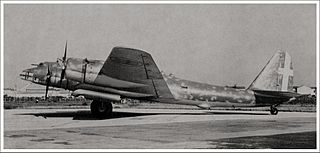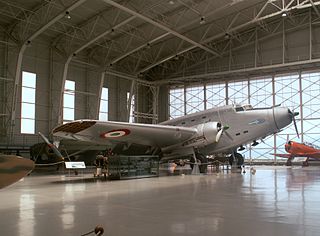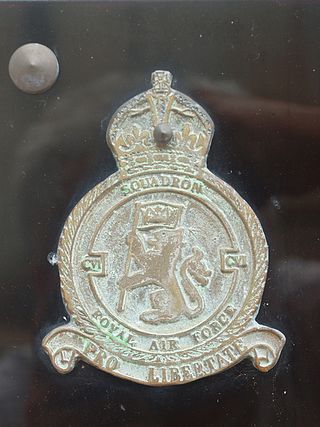Bahrain and Dhahran
Early on 19 October 1940, four Italian SM.82 bombers attacked American-operated oil refineries in the British Protectorate of Bahrain, damaging the local refineries. [3] The raid also struck Dhahran in Saudi Arabia, but causing only some minor damage. [3]
Indeed, in order to strike the British-controlled oil refineries at Manama in the Persian Gulf, these SM.82 bombers undertook a flight of 4,200 km (2,610 mi), lasting 15 hours at 270 km/h (170 mph), that was for the time arguably a record for a bombing mission. The force took off from the island of Rhodes, in the Aegean Sea, and each aircraft carried a bomb load of 1,500 kgs (3,310 lbs). [4] This long-range action was successful, taking the target totally by surprise, and the SM.82s landed without problems at Zula, Eritrea. The Italian airplanes started their flight from Europe, attacked refineries in Asia and landed back in Africa (Italian Eritrea).
During the attack 132 bombs of 15 kgs each were dropped, that heavily damaged two refineries. [5]
The raid caused the Allies some concerns, forcing them to upgrade their defenses. This, more than the limited amount of damage caused, further stretched Allied military resources.
The Italian Command intended to employ the special SM82s to bomb the English oil plants of Manama, in the Persian Gulf, in order to show the potential ability of the Italian air force. It was a long and difficult mission involving a 4,000 kilometre flight. Ettore Muti and his comrades spent four days working on a complete revision of the plans and established a complex flight plan. ... On December 18, at 5.10 pm, after filling both the normal and the supplementary tanks, they loaded three out of four SM82s with 1.5 tons of incendiary and explosive bombs weighing 15, 20 or 50 kilograms. Then the four three-engine bombers took off. In command of the first aircraft, which gained height with difficulty from the Rhodes-Gadurrà runway because it was overloaded with 19,500 kilograms, was Lieutenant Colonel Muti. He was assisted by Major Giovanni Raina and by Captain Paolo Moci, who had previous experience in flying planes overloaded up to 21 tons. ... The SM82s, after gaining height (a manoeuvre which took remarkable efforts because of the enormous weight of the aircraft) headed east, flying over Cyprus, Lebanon and Syria, bending to the southeast as they went past Jordan and Iraq until they reached the Persian Gulf. During the very long outward flight, the role of Muti's SM82 pathfinder proved its essential function in leading the squadron. ... At 2.20 am, just before reaching the Bahrain Islands, Lieutenant Colonel Federici's aircraft suddenly lost sight contact with Muti's SM82 and had to drop its bombs on different targets in the vicinity of Manama, while the other planes hit the fixed target. As bombardier Raina later told "the operation of spotting the target was easy thanks to the total illumination of the extractive and refinery plants" which were partially damaged by the bombs (half a dozen wells and some oil deposits were set on fire). As soon as they perceived the glares of the first explosions, the Italian planes made off along the escape route landing to the Zula runway (Eritrea) at 8 8:40.The whole Italian formation had flown 2,400 kilometres in 15.30 hours. At the Eritrean airport, along with a small crowd of Italian aviators, the brave pilots found the fourth SM82 squadron which, in the meantime, had come from Rhodes as a support plane on the way back, should one of the crafts make an emergency landing in the desert. — Alberto Rosselli [6]
Rome declared that their bombers had set a new distance record, covering 3,000 miles on the outgoing trip from bases located in the island of Rhodes. American magazine Time wrote that the Italians insisted that the planes had been refueled from submarine tankers [7] though in actuality, the planes had simply been loaded with fuel. [3]
Ettore Muti, party secretary of the National Fascist Party, took part in the Bahrain raid and in at least one of the bombings of Haifa. [8]
The Bahrain raid was followed by other long-distance Italian raids on Ethiopia and Eritrea in 1942, and would have been repeated -with an advanced SM.82 bomber- in a raid on New York City in summer 1943 that never became true. Even a commercial aerial trip was done between Rome and Tokyo in summer 1942. [9]
The Royal Italian Air Force (RAI) was the name of the air force of the Kingdom of Italy. It was established as a service independent of the Royal Italian Army from 1923 until 1946. In 1946, the monarchy was abolished and the Kingdom of Italy became the Italian Republic, whereupon the name of the air force changed to Aeronautica Militare.

The Savoia-Marchetti SM.79 Sparviero was a three-engined Italian medium bomber developed and manufactured by aviation company Savoia-Marchetti. It may be the best-known Italian aeroplane of the Second World War. The SM.79 was easily recognizable due to its fuselage's distinctive dorsal "hump", and was reportedly well liked by its crews, who nicknamed it il gobbo maledetto.
This is a list of aviation-related events from 1940:
This is a list of aviation-related events from 1943:
This is a list of aviation-related events from 1944:

The Piaggio P.108 Bombardiere was an Italian four-engine heavy bomber that saw service with the Regia Aeronautica during World War II. The prototype first flew on 24 November 1939 and it entered service in 1941. It was one of a handful of Italian combat aircraft that could match the best manufactured by the Allies. Four versions of the P.108 were designed, but only one, the P.108B bomber, was produced in any quantity before the armistice. The other variants included the P.108A anti-ship aircraft with a 102 mm (4 in) gun, the P.108C, an airliner with an extended wingspan and re-modelled fuselage capable of carrying 32 passengers, and the P.108T transport version designed specifically for military use. Only one P.108A and 24 P.108Bs were built. The combined total number of all versions was at least 39, almost certainly more than 44. Most of the P.108Cs were subsequently modified for use as military transport aircraft and could accommodate up to sixty passengers. Nine P.108 Ts were used by Luftwaffe transport units until the end of the war.

Operation Tidal Wave was an air attack by bombers of the United States Army Air Forces (USAAF) based in Libya on nine oil refineries around Ploiești, Romania on 1 August 1943, during World War II. It was a strategic bombing mission and part of the "oil campaign" to deny petroleum-based fuel to the Axis powers. The mission resulted in "no curtailment of overall product output".

The Italian bombing of Mandatory Palestine in World War II was part of an effort by the Italian Royal Air Force to strike at the United Kingdom by attacking those parts of the British Empire in the Middle East.

The Savoia-Marchetti SM.82 Marsupiale is an Italian bomber and transport aircraft of World War II. It was a cantilever, mid-wing monoplane trimotor with a retractable, tailwheel undercarriage. There were 875 built, the first entering service in 1940. Although able to operate as a bomber with a maximum bombload of up to 8,818 lb (4000 kg), the SM.82 saw very limited use in this role. The SM.82 was the foreign aircraft used in largest number by the Luftwaffe, which operated several hundreds of this aircraft, as a transport. Post-war about 30 SM.82s continued in service with the Aeronautica Militare Italiana, many remaining in service until the early 1960s.

The Savoia-Marchetti SM.75 Marsupiale was an Italian passenger and military transport aircraft of the 1930s and 1940s. It was a low-wing, trimotor monoplane of mixed metal and wood construction with a retractable tailwheel undercarriage. It was the last of a line of transport aeroplanes that Alessandro Marchetti began designing in the early 1930s. The SM.75 was fast, robust, capable of long-range flight and could carry up to 24 passengers for 1,000 miles.

The Corpo Aereo Italiano, or CAI, was an expeditionary force from the Italian Regia Aeronautica that participated in the Battle of Britain and the Blitz during the final months of 1940 during World War II. The CAI supported the German Air Force (Luftwaffe) and flew against the British Royal Air Force (RAF) and Fleet Air Arm (FAA). The CAI achieved limited success during its brief existence, but it was generally hampered by the inadequacy of its equipment.

The Savoia-Marchetti SM.85 was an Italian monoplane dive bomber and ground-attack aircraft that served in small numbers in the Regia Aeronautica at the beginning of World War II. They were soon replaced in service by the Junkers Ju 87.

No. 106 Squadron RAF was a Royal Flying Corps and Royal Air Force squadron active from 1917 until 1919, throughout World War II and during the Cold War from 1959 until 1963.

The Savoia-Marchetti SM.84, not to be confused with the Savoia-Marchetti S.84 airliner prototype, was an Italian bomber aircraft of World War II. It was designed by Savoia-Marchetti as a replacement for its successful SM.79, and shared its three-engine layout. Despite entering service with the Regia Aeronautica in 1941, it was retired from service before the SM.79 and never fully replaced it.

The Savoia-Marchetti SM.81 first saw combat during the Second Italo-Abyssinian War, where it showed itself to be versatile, serving as a bomber, transport and reconnaissance aircraft. SM.81s also fought in the Spanish Civil War with the Aviazione Legionaria and were among the first aircraft sent by the fascist powers to aid Francisco Franco.

Gura or Gura'e is a settlement in Eritrea's Debub region in northeast Africa. It is located in the eponymous Gura Valley in the southeastern Eritrean highlands. It is about 9 kilometers (5.6 mi) SE of Dekemhare and about 32 kilometres (20 mi) SSE of the capital Asmara.

Operation Boomerang was a partially successful air raid by the United States Army Air Forces' (USAAF) XX Bomber Command against oil refining facilities in Japanese-occupied Dutch East Indies during World War II. The attack took place on the night of 10/11 August 1944 and involved attempts to bomb an oil refinery at Palembang and lay mines to interdict the Musi River.

During World War II, Tuscany, the Italian port city of Livorno was repeatedly bombed by the Allied air forces, suffering about a hundred raids altogether, which resulted in it being among the most war-damaged cities in Italy.

Fernando Silvestri was an Italian Air Force general during World War II.















